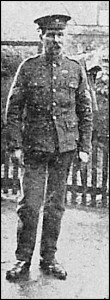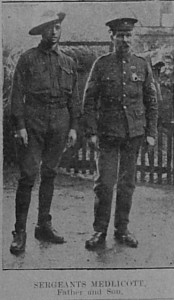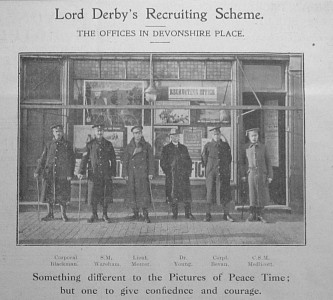Category: Military
Rank: Company Sergeant Major
Regiment or Ship: Royal Garrison Artillery
Service Number(s): 604016 (or 604076); 1662425
Occupation: Professional Soldier
Date of Birth: 1850
Place of Birth: Cold Aston, Gloucestershire
Date of Death: 14.05.1936
Place of Death: Hastings registration district
Address: 89 Windsor Road, Bexhill
Photos and newspaper articles
Family Information
Parents: Thomas George Medlicott (1827-1884) and Elizabeth Ann Lea Medlicott – nee Fisher – (1828-1911).
Siblings:
James Medlicott (1853-).
Walter Medlicott (1854-).
Mary Ann Medlicott (1855-).
John Medlicott (1858-).
Alfred Medlicott (1859-).
Rose A. Medlicott (1860-).
William George Medlicott (1860-).
Catherine Medlicott (1862-).
Florence Medlicott (1865-).
Alfred Medlicott (1868-).
Sarah Ann Medlicott (1869-).
Charles Medlicott (1875-).
Spouse: Edwin married Henrietta Owens and they had at least seven children: ‘G’, James, Thomas, Edwin, William, Albert, Henrietta.
In the 1901 census Edwin was an Army Pensioner living at 89 Windsor Road, Bexhill on Sea. – moving there from 14 South Terrace, Ore, where he lived in 1891.
First World War Experience
Edwin’s main WW1 service seems to have been recruiting and an article in the Bexhill Chronicle dated 15th August 1914 states:
“Lord Kitchener’s Army. Sergt.-Major Medlicott, 89 Windsor Road, is the local representative of Col. Whittle, the chief of the district, and he has already enrolled a number of recruits.”
In the same newspaper dated 2.1.1915 there appears a very nice photograph of Edwin and one of his sons from the Commonwealth and the transcription of the report reads:-
“Returned to Fight for the Old Country
Sergeant Medlicott, who has played such an active part in recruiting in Bexhill since the War started, has a family who have “followed in father’s foot-steps” in regard to service with the Colours. He has three sons in Canada, all of whom have served in the Boer War, and two of whom are expected here with later contingents of Canadians; he has one of a heavy battery at Woolwich, and there has just visited Bexhill this week still another, who has had an adventurous and successful career in Australia for the past three years, and returned with the Australian troops to join his old regiment, the 6th Dragoon Guards (Carbineer’s).
He describes Australia as a flourishing and prosperous country. He has been engaged there in milking and farm work, horse breaking, shearing, cane-cutting, and boundary riding. The last-mentioned, he says is a lonely job. He got into the way of talking to his horse, talking to his dogs, and eventually, he says, “I began talking to myself, so I got tired of it and came back.”
There was a grand ‘round up’ when the soldiers who had served together in all parts of the world met to join the Australian contingent. He leaves a wife and young family in Australia.
On their way here the interesting break in the voyage was the “Sydney’s” sinking of the “Emden”. The battle naturally created the greatest interest and excitement aboard the transports.”
Again, in the same local newspaper, this time dated12.6.1915 the following letter appears from one of his sons – G is the only detail we have –
“Letter from Lance-Corporal G. Medlicott to his father, Sergeant Medlicott, Windsor Road.
A few lines in answer to your welcome letter, which I received quite safe. I am glad to hear that you are in better health, as it leaves me in the ‘pink’. We came out of the trenches on Saturday morning early, after doing seven days in the front line; we relieved another division that got cut up pretty badly, but we came out rather lucky. We are resting to-day, and off we go we don’t know where, and we get that way that we don’t care where so long as they don’t give us gas. I’ve had one lot, and that is quite enough. I like to have a sporting chance for my life, and not get a dirty kick in the back of the neck.
I would like a little more of that shag, if you will send me some. We were in the trenches without a smoke between us. It’s not quite the thing having to go without a smoke, while the ‘Terriers’ seem to get plenty issued.”
Another nice photograph of Edwin appeared in the same newspaper, this time on Christmas Day 1915, headed “Lord Derby’s Recruiting Scheme. The Offices in Devonshire Place.”
As far as the researcher can ascertain Edwin served in the Royal Horse Artillery, the Royal Field Artillery, and the Royal Garrison Artillery. He was awarded both the Victory British Medal and the T. P. War Medal.




